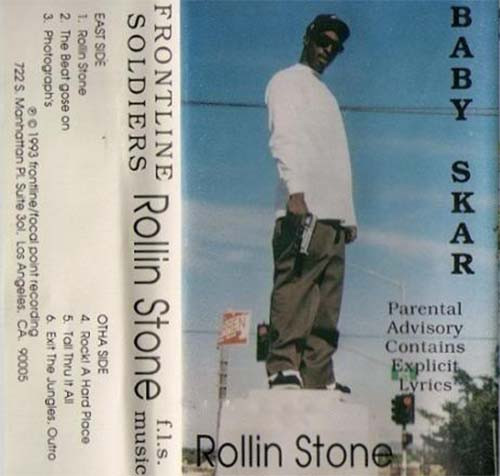Baby Skar – Rollin Stone
January 1, 1993
Download music album Rollin Stone by Baby Skar, released in 1993. ℗ F.L.S. Music

Album info
“Rollin Stone” by Baby Skar, released on F.L.S. Music in 1993, emerges as a gritty and raw portrayal of life on the streets through the eyes of a San Diego-based rapper known for his affiliation with the Skyline Piru set. The cassette format of the album reflects the era’s authentic underground scene, where hip-hop was as much about the message as it was about the medium.
Side A, labeled as the East Side, kicks off with the eponymous track “Rollin Stone,” setting the tone with hard-hitting lyrics over a funk-laden beat that harks back to the roots of West Coast rap. The following track, “The Beat Goes On,” maintains the momentum with a relentless rhythm that underscores the persistent nature of street life and the continuous struggle for respect and survival.
“Photograph’s” closes Side A with a more introspective note, painting vivid lyrical pictures of memories and moments that define the rapper’s journey. It’s a reflective piece that contrasts the album’s otherwise hard exterior, showcasing Baby Skar’s depth as an artist.
On the Otha Side, or Side B, “Rock! A Hard Place” delves into the dichotomous nature of the streets, where the allure of fast money and respect comes with the price of potential downfall and violence. The track “Tall Thru It All” is a testament to resilience, a narrative that speaks to standing tall amidst the chaos and challenges that define Baby Skar’s environment.
The closing piece, “Exit The Jungles, Outro,” serves as a thematic bookend to the album. It’s a stark reminder of the harsh realities faced by many in the urban jungle while also signaling an end to the musical journey, leaving listeners to ponder the stories they’ve just heard.
“Rollin Stone” stands as a snapshot of early ’90s gangsta rap, a time capsule of the sounds and stories from the streets of San Diego. As a member of the Dulo Gang collective, Baby Skar’s album is not just a personal narrative but also a piece of the broader tapestry of West Coast hip-hop history.
